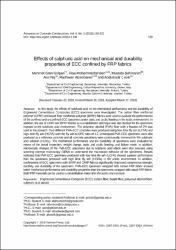| dc.contributor.author | Gülşan, Mehmet Eren | |
| dc.contributor.author | Mohammedameen, Alaa | |
| dc.contributor.author | Şahmaran, Mustafa | |
| dc.contributor.author | Niş, Anıl | |
| dc.contributor.author | Alzeebaree, Radhwan | |
| dc.contributor.author | Çevik, Abdulkadir | |
| dc.date.accessioned | 2024-03-20T02:47:49Z | |
| dc.date.available | 2024-03-20T02:47:49Z | |
| dc.date.issued | 2018 | en_US |
| dc.identifier.issn | 2287-5301 | |
| dc.identifier.issn | 2287-531X | |
| dc.identifier.uri | https://hdl.handle.net/11363/7238 | |
| dc.description.abstract | In this study, the effects of sulphuric acid on the mechanical performance and the durability of
Engineered Cementitious Composites (ECC) specimens were investigated. The carbon fiber reinforced
polymer (CFRP) and basalt fiber reinforced polymer (BFRP) fabrics were used to evaluate the performances
of the confined and unconfined ECC specimens under static and cyclic loading in the acidic environment. In
addition, the use of CFRP and BFRP fabrics as a rehabilitation technique was also studied for the specimens
exposed to the sulphuric acid environment. The polyvinyl alcohol (PVA) fiber with a fraction of 2% was
used in the research. Two different PVA-ECC concretes were produced using low lime fly ash (LCFA) and
high lime fly ash (HCFA) with the fly ash-to-OPC ratio of 1.2. Unwrapped PVA-ECC specimens were also
produced as a reference concrete and all concrete specimens were continuously immersed in 5% sulphuric
acid solution (H2SO4). The mechanical performance and the durability of specimens were evaluated by
means of the visual inspection, weight change, static and cyclic loading, and failure mode. In addition,
microscopic changes of the PVA-ECC specimens due to sulphuric acid attack were also assessed using
scanning electron microscopy (SEM) to understand the macroscale behavior of the specimens. Results
indicated that PVA-ECC specimens produced with low lime fly ash (LCFA) showed superior performance
than the specimens produced with high lime fly ash (HCFA) in the acidic environment. In addition,
confinement of ECC specimens with BFRP and CFRP fabrics significantly improved compressive strength,
ductility, and durability of the specimens. PVA-ECC specimens wrapped with carbon FRP fabric showed
better mechanical performance and durability properties than the specimens wrapped with basalt FRP fabric.
Both FRP materials can be used as a rehabilitation material in the acidic environment. | en_US |
| dc.language.iso | eng | en_US |
| dc.publisher | TECHNO-PRESS, PO BOX 33, YUSEONG, DAEJEON 305-600, SOUTH KOREA | en_US |
| dc.relation.isversionof | https://doi.org/10.12989/acc.2018.6.2.199 | en_US |
| dc.rights | info:eu-repo/semantics/openAccess | en_US |
| dc.subject | Engineered Cementitious Composite (ECC) | en_US |
| dc.subject | carbon fiber | en_US |
| dc.subject | basalt fiber | en_US |
| dc.subject | polyvinyl alcohol fiber | en_US |
| dc.subject | sulphuric acid attacks | en_US |
| dc.title | Effects of sulphuric acid on mechanical and durability properties of ECC confined by FRP fabrics | en_US |
| dc.type | article | en_US |
| dc.relation.ispartof | ADVANCES IN CONCRETE CONSTRUCTION | en_US |
| dc.department | Mühendislik ve Mimarlık Fakültesi | en_US |
| dc.authorid | https://orcid.org/0000-0001-9092-8088 | en_US |
| dc.identifier.volume | 6 | en_US |
| dc.identifier.issue | 2 | en_US |
| dc.identifier.startpage | 199 | en_US |
| dc.identifier.endpage | 220 | en_US |
| dc.relation.publicationcategory | Makale - Ulusal Hakemli Dergi - Kurum Öğretim Elemanı | en_US |
| dc.contributor.institutionauthor | Niş, Anıl | |

















